#912 Now that the coast is clear
Sailing with Vancouver: A Modern Sea Dog, Antique Charts and a Voyage Through Time
by Sam McKinney
Victoria: TouchWood Editions, 2018 (first published 2010)
$20.00 / 9781771512640
Reviewed by Brian Harvey
*
 I once got the urge to see all the apartments and houses where the British writer Malcolm Lowry had lived during his years in Vancouver. I had been reading Douglas Day’s 1974 biography of the author of Under the Volcano, and it helpfully included all the relevant addresses. There were a half dozen or so, although I would have to use my imagination for the most significant dwelling on the list, the squatter’s shack on the beach in Dollarton where Lowry and his long-suffering wife Marjorie lived for 14 mostly happy years, and where he completed Under the Volcano. The shacks are long gone; the area is now Cates Park. But I was moved by Lowry’s short life and of course by the astonishing novel that may as well have been the only thing he ever wrote, so I took the ferry to Vancouver and worked my way doggedly down Day’s list. This was before cars had GPS, which would have made the hunt easier but no longer much of a hunt. There was a lot of neck-craning. Most of the places were in the West End. Where there was parking, I got out, stared at a likely window, felt silly and drove off. I don’t remember having any profound thoughts. They were just houses. A few people gave me funny looks. The odds were excellent they had no idea Lowry had lived there, and even better that they’d never heard of him.
I once got the urge to see all the apartments and houses where the British writer Malcolm Lowry had lived during his years in Vancouver. I had been reading Douglas Day’s 1974 biography of the author of Under the Volcano, and it helpfully included all the relevant addresses. There were a half dozen or so, although I would have to use my imagination for the most significant dwelling on the list, the squatter’s shack on the beach in Dollarton where Lowry and his long-suffering wife Marjorie lived for 14 mostly happy years, and where he completed Under the Volcano. The shacks are long gone; the area is now Cates Park. But I was moved by Lowry’s short life and of course by the astonishing novel that may as well have been the only thing he ever wrote, so I took the ferry to Vancouver and worked my way doggedly down Day’s list. This was before cars had GPS, which would have made the hunt easier but no longer much of a hunt. There was a lot of neck-craning. Most of the places were in the West End. Where there was parking, I got out, stared at a likely window, felt silly and drove off. I don’t remember having any profound thoughts. They were just houses. A few people gave me funny looks. The odds were excellent they had no idea Lowry had lived there, and even better that they’d never heard of him.
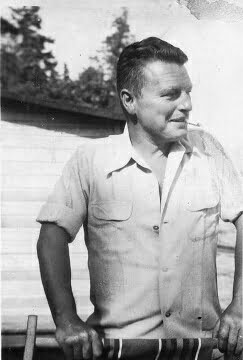
Why would I do this? I wasn’t writing a book about Lowry, or otherwise looking for inspiration. But travelling in the footsteps of famous people is something a lot of people seem compelled to do, and I doubt many of them could come up with anything more concrete than, “Just curious, I guess.” If you Google “in the footsteps of”, however, that curiosity is everywhere, from articles to books to documentary films to a long and inventive list of guided tours to ordinary places made famous by extraordinary people. Jesus Christ is a favourite, but he has a lot of non-divine company. I didn’t know Henri Matisse spent time in Morocco, but you can buy a travel guide to his favourite haunts. You can trudge after David Livingstone in Africa, see what Alexander the Great saw, even try and keep up with James Bond on a winding mountain road high above the Cote d’Azur — and he didn’t even exist. Battlefield tours are especially popular; if you want to see where Britain overcame the Argentines in the Falkland Islands, a cruise ship can take you there. And if Jesus and Dr. Livingstone are too stuffy, a travel company called Satopia will sell you a Steve Jobs experience in Kyoto or Snoop Dogg’s search for “peace and wisdom” in Jamaica. For the Jobs tour, you get to eat at Steve’s favourite sushi restaurant.

Following somebody’s footsteps is straightforward as long as you’re on land and not heading straight up a mountain. It’s easy to make fun of, especially if the route just happens to include five-star restaurants and sushi bars. To be fair, some journeys are intensely personal and the person making them is motivated not by fandom but by some closely connected event in history. One such is Naomi K. Lewis, whose 2019 memoir Tiny Lights for Travellers has her visiting specific locations in Europe that played roles in her grandfather’s escape through Nazi-occupied territory in 1942.
But what if your hero travelled by sea? What if you must follow a wake, not footsteps? Renting a stateroom on a freighter crossing the Atlantic seems an unsatisfying way to follow Christopher Columbus, so for most acolytes of seafaring heroes there’s only one option: buy a boat. This narrows the field dramatically. But Sam McKinney did it, at the age of seventy, so that he could sail in the wake of Captain George Vancouver as he fulfilled his mission to explore, chart and secure for Britain as much as possible of the western coast of North America, from San Francisco to Alaska. McKinney turned his pursuit along a portion of that coastline into Sailing with Vancouver: A Modern Sea Dog, Antique Charts and a Voyage Through Time (Touchwood Editions 2018).
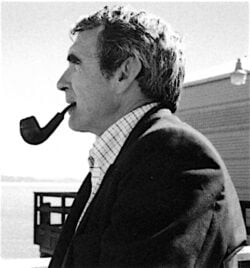
All those people who live in Vancouver who get their car serviced at Vancouver Auto or follow the Vancouver Canucks — how many know who George Vancouver was? Even if they do, the things he accomplished and the places he and his men visited between 1791 and 1795 would be news to most. And what does it even mean to the average person that Vancouver led two sailing ships into every gloomy fjord, around every tree-clad island, over unseen rocks and often through dumbfounding and dispiriting fog, from Puget Sound to Prince Rupert? That he and a half dozen men set out from the mother ship in twenty-foot open boats, often for a week or more, took sightings, recorded depths, looked for water and bartered with Indigenous people who had never seen a white person? It’s just words, and the most they can convey is a sense of perseverance in the face of the arduous. Unless — and this is where the field narrows most dramatically — you are a sailor.
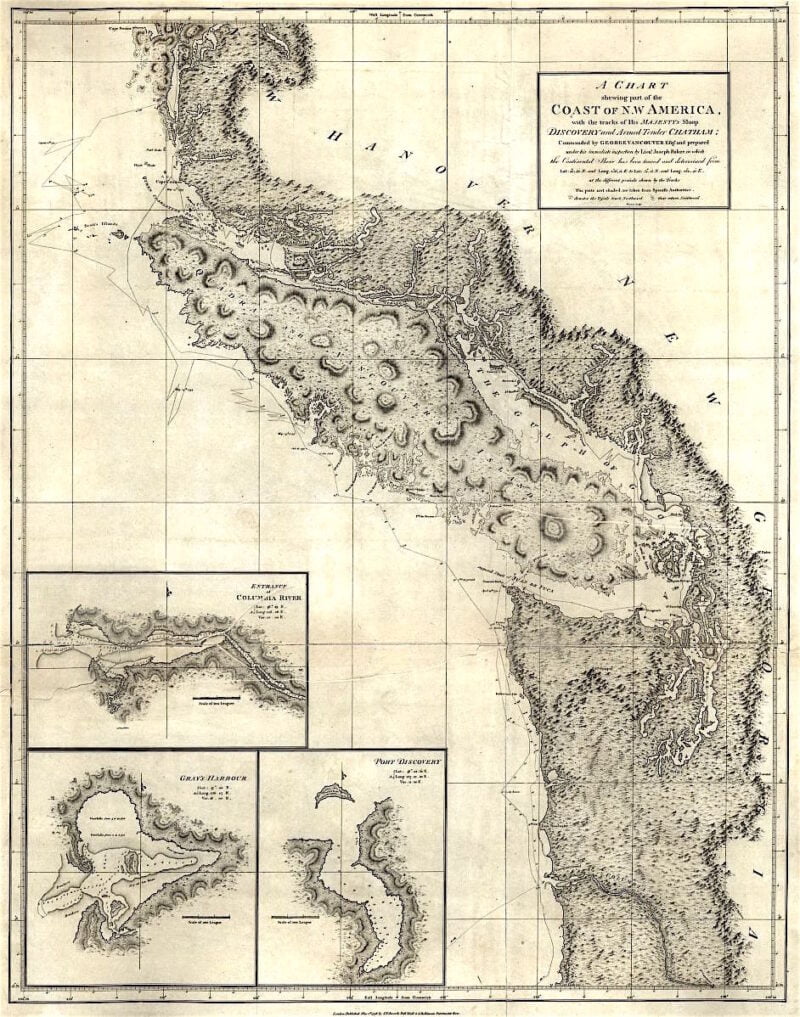
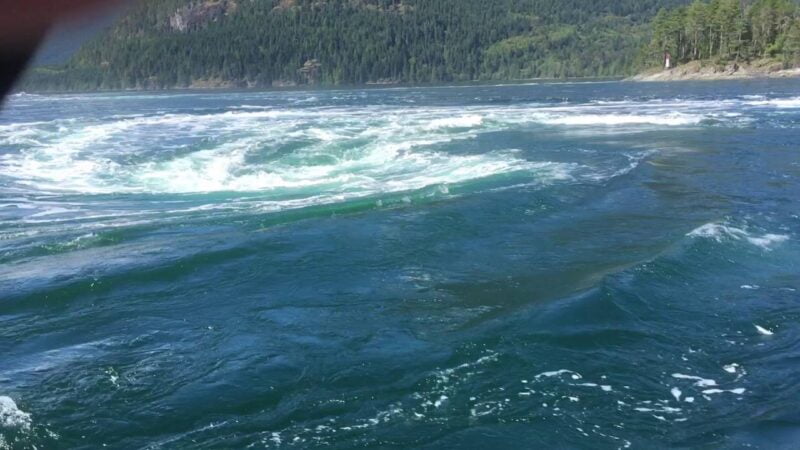
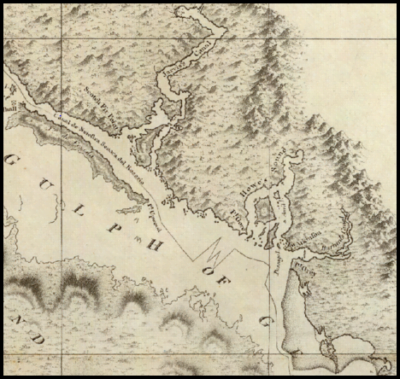
Sam McKinney was a sailor. For him — for any boater — the image of one of Vancouver’s longboats being spun end for end in fog-choked and uncharted Dent Rapids, where the tidal current can exceed 10 knots, would be chilling. Even now, when GPS and digital current tables have eliminated most of the uncertainty of running a tidal rapid like Dent (what McKinney calls the “unbridgeable difference between my voyage and theirs”), many boaters will back away. McKinney did not; instead, he decided to use his knowledge of sailing and his fascination with Vancouver’s voyages to follow, as closely as possible, the path of the HMS Discovery and the HMS Chatham through the portion of the voyages that ran from Puget Sound (where McKinney then lived) through the Canadian Gulf Islands and up the eastern side of Vancouver Island. This route took him through Desolation Sound (a place he found a good deal less welcoming than do the thousands of recreational boaters who visit it today) and the more challenging Broughton Archipelago but did not include the west coast of Vancouver Island or the maze of mainland fjords north of Cape Scott. It’s still quite an itinerary. The maritime challenges are unrelenting and the scenery overwhelms — all those narrows and nooks, those islands so thickly treed the cedars dip their skirts in the water at high tide, those sudden vistas where the mountains seem to come right down to the sea.
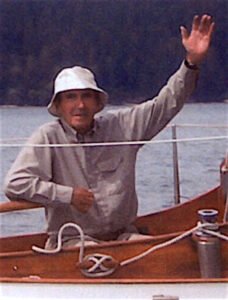
People who write about their sailing experiences come in two flavours: Fervent and Laconic. A Fervent account is unexpurgated. If there is a stone, it will be turned, even if all the stones look pretty much the same. Laconic will get you from A to B without fuss or detail; Fervent will invent whole new subsets of the alphabet for the same journey.
Sam McKinney is a Laconic. His descriptions of the surroundings he finds himself in are deft but not exhaustive, and the actual act of sailing his 25-foot wooden boat — whose purchase from an old-timer in Nanaimo is a lively piece of scene-setting that reveals just what a reader needs to know about the author — gets little attention. People looking for breathless accounts of gales and knockdowns won’t find them in Sailing with Vancouver, and I sometimes found myself wondering where he was going, and where he had been last. A detour he makes to Nanaimo and Chemainus seems unconnected to his pursuit of Vancouver and reads like uncritical travelogue, and even in Desolation Sound, which is firmly in Vancouver territory, I had to scratch my head over where McKinney must have anchored to have received such a negative impression. (I think I know where it was, but anybody who craves quiet knows not to go there). The maps at the beginning of the book do not show the locations where McKinney stopped.
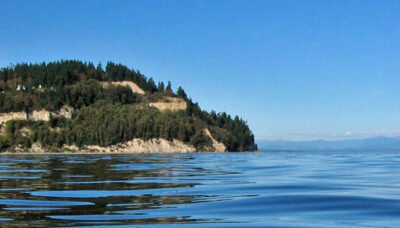
But Sailing with Vancouver isn’t really about McKinney. We do come to know him as the voyage continues, and he tells us early on that he’s a “restless person” whose fourth-grade school desk became a scratched and penciled secret chart of the South Sea islands, and that he would have liked to have been a member of Vancouver’s expedition. He has a gift for images: coastal island mazes like pieces of a jigsaw puzzle; the shoreline “twisting and turning along its length like the dribbled edge of spattered paint.” I could, however, have done with less of the place-name attribution that McKinney seems compelled to do for every island, strait, bay, rapid or mountain. We get it that they were all named after naval men, or patrons, or wives, even a famous racehorse. Including every single one plus an Afterword on place names just makes it harder to stomach how confidently western explorers co-opted lands that had been lived on for thousands of years. McKinney tells the story of the ceremony at Possession Point in which Vancouver took “formal possession of all the countries we have lately been employed in exploring in the name of and for His Britannic Majesty”– a Majesty who went mad twenty years later. It’s not easy reading, especially at a time when statues of Christopher Columbus are being toppled as unwelcome reminders of the European takeover of Indigenous lands.

Where Sailing with Vancouver really shines is in recounting the actual historic expedition. McKinney does what any Vancouver biographer is compelled to do: boil the captain’s own weighty record of the voyage down to a tight narrative that gives the reader a fighting chance at comprehending what Vancouver and his crew went through. In this task he is aided by the celebrated B.C. historian W. Kaye Lamb, whose introduction to Vancouver’s turgid three volume report provides many biographic details. More recent biographers have added intriguing insights to the Lamb account. In Stephen Bown’s Madness, Betrayal and the Lash (2008), for example, the botanist Archibald Menzies, who accompanied Vancouver on his travels and left his own journal, is not the affable scientist-surgeon McKinney describes. According to Bown, the two men disliked each other intensely, with Vancouver strongly resenting the machinations of Sir Joseph Banks, president of the Royal Society and a veteran himself of Cook’s expedition to Hawaii, that got Menzies onto his ship. The “lash” part of Bown’s title does, however, make it into McKinney’s book, where the exemplary nature of flogging as a punishment is well presented. Flogging kept the voyages of Vancouver’s day running smoothly. A bungled sounding that led to a grounding of the HMS Discovery got the offending seaman 36 lashes.
Navigation was everything, especially for the chart-makers themselves. Sailing with Vancouver contains superb explanations of such essentials as the science of navigation in Vancouver’s time and the nature of tides and currents. Interspersing these backgrounders with descriptions of a Georgian seaman’s life (he got a gallon of beer per day), highlights of the places visited and thoughtfully selected quotes from Vancouver himself (including one recounting his anxiety at entering Queen Charlotte Strait, a place that was the bailout point for McKinney) result in a book that’s very well paced — an achievement that would have been much more difficult if McKinney had insisted on including a lot of detail on his own comings and goings.
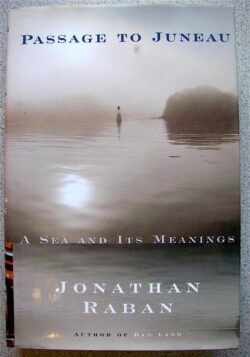
As a “footsteps” experience, where does Sailing with Vancouver lie on the continuum from the silly (enlightenment with Snoop Dogg in Jamaica) to the deeply personal (Naomi K. Lewis and her grandfather’s flight to freedom)? Well to the Lewis end, I think, although McKinney was clearly not out to “find himself” — he lets us know early on what makes him tick, and that he’s fine with it. He has a predecessor in Jonathan Raban, whose Passage to Juneau (1992) also has the author single-handing up the Inside Passage clutching a copy of Vancouver’s report. But Raban’s account is more consciously erudite (we learn much about his eclectic choice of reading material, and McKinney seems to have managed without Homer and Anthony Trollope), and he’s the opposite of self-effacing. The two books are as different as their authors. Raban’s agenda was complicated and personal, and his book ends in personal catastrophe. McKinney, it seems to me, just wanted to see what it felt like being in the places Vancouver wrote about, to follow an “established course of historical significance.” Their books are more complementary than competitive. Both authors lived in Washington state, near the start of Vancouver’s coastal peregrinations; today, neither would be permitted in Canadian waters until the US-Canada border reopens. In Desolation Sound and the Broughton Archipelago in the summer of 2020, there isn’t an American boat to be seen. It’s like going back to the sixties.
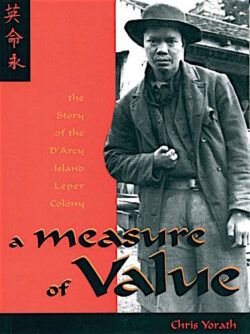
Do places have a palpable aura that evokes their history? Does that make them worth seeking out? If they do, the whole business of travelling in footsteps begins to be explainable. Yet when McKinney stops briefly at D’Arcy Island in Haro Strait, to which a small colony of Chinese lepers was banished until 1924, he level-headedly describes it as a “lovely place” that belies its dark history. The romanticized reputation of D’Arcy as haunted and gloomy seems not to affect him.
Either way, if one is to be affected by the history of a place, that history has to be known. Whether it actually touches you is another matter. I knew that a scruffy apartment building on Davie Street in Vancouver was, for a time, home to Malcolm Lowry; even so, I can’t claim the sight of it moved me. Nor did passing Galiano Island recently in my own sailboat, even though the place should have reeked of George Vancouver. The truth is, Coastal British Columbia is drenched in history, and everybody sailing there is “sailing with Vancouver.” It’s impossible not to. The difference Sam McKinney has made is to add structure and an actual storyline to that vague feeling that “Vancouver is everywhere.” He’s done what the best teachers do: teach without seeming to. After reading Sailing with Vancouver you will know a great deal about places you’ve seen countless times through the ferry window, and names you’ve heard but never knew who they belonged to. And you will be enriched. All because a restless seventy-year-old did the legwork.
*
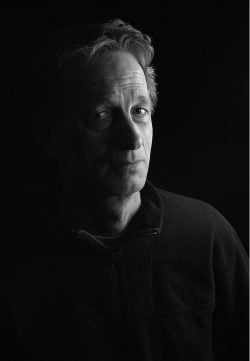
Brian Harvey grew up on the West Coast of Canada and trained as a marine biologist. He began writing newspaper columns and science-travel articles for magazines in 1997. His first book for a general audience (The End of the River) was a Globe and Mail “Best 100” book for 2008 and was followed by two works of fiction (Beethoven’s Tenth and Tokyo Girl). His latest book, Sea Trial: Sailing After My Father, was a 2019 Governor General’s Award finalist for nonfiction and an Independent Publishers Book Awards medalist in the memoir category. See here for a review of Sea Trial by Theo Dombrowski. Brian lives in Nanaimo.
*
The Ormsby Review. More Books. More Reviews. More Often.
Publisher and Editor: Richard Mackie
The Ormsby Review is a journal service for in-depth coverage of B.C. books and authors. The Advisory Board consists of Jean Barman, Robin Fisher, Cole Harris, Wade Davis, Hugh Johnston, Patricia Roy, David Stouck, and Graeme Wynn. Scholarly Patron: SFU Graduate Liberal Studies. Honorary Patron: Yosef Wosk. Provincial Government Patron since September 2018: Creative BC
“Only connect.” – E.M. Forster

2 comments on “#912 Now that the coast is clear”